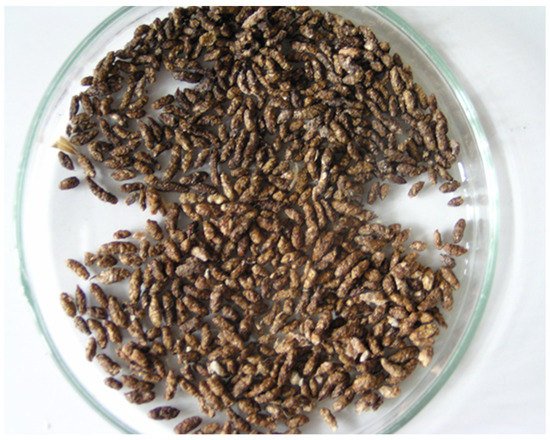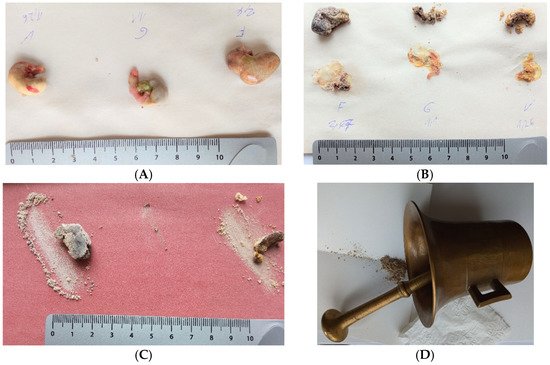
| Version | Summary | Created by | Modification | Content Size | Created at | Operation |
|---|---|---|---|---|---|---|
| 1 | Ladislav Čepelka | + 2443 word(s) | 2443 | 2021-12-09 08:57:43 | | | |
| 2 | Jason Zhu | Meta information modification | 2443 | 2022-01-17 04:00:46 | | |
Video Upload Options
The near-infrared spectroscopy (NIRS) method proved to be a useful tool to determine the amount of a particular food ingredient in the diet from faeces or chyme and to estimate the food quality.
1. Brief Introduction to Near-Infrared Spectroscopy (NIRS)
2. Specifics of Using the NIRS Method in Wild Rodents
2.1. Analysis of Faeces

2.2. Analysis of Stomach Contents

2.3. Calibration
3. What Has Already Been Found?
3.1. NIRS Analysis of Rodent Dietary Preferences
3.2. Rodent Stomach Sample Preparation for the NIRS Analysis
3.3. NIRS Analysis of Rodents Food Quality in Forest Habitats
3.4. NIRS Analysis of Rodents Food Quality in Arable Landscape
Three articles dealt with the study of food quality by the NIRS method of the most numerous rodents in Central European agroecosystems. In the first article, changes in the quality of food were observed in two populations of Microtus arvalis (the most numerous rodents in this habitat). A higher proportion of nitrogenous substances was found in breeding females at the highest population densities [34]. The second article compared the food quality of A. sylvaticus and M. arvalis in extensively and intensively agriculturally used localities. The effect of population density, crop, and season on the food quality was found in both species [35]. The third article sought to verify whether the knowledge found in previous works on food of the genus Apodemus can be applied to A. uralensis; it is the dominant species in some areas together with the M. arvalis. A. uralensis’ food was shown to have, on average, a lower proportion of nitrogenous substances and higher variability; the food quality was influenced by the season. In M. arvalis, the most important factor was the overall abundance of rodents [36]. A strong correlation was found between food quality and population density in the common vole and wood mouse [35][36]. This finding clearly confirms that food quality is related to rodent population dynamics. In arable ecosystems, the amount of nitrogen in consumed food differs in various crops in relation to their nitrogen content [35]. In forest and arable habitats, reproduction and season of year were also reflected in changes in food quality [34][33] in contrast to sex, body size, and age.
4. Conclusions
The NIRS method has been used only rarely to study small mammals; this is a shame, especially in connection with the invention of microsensors that have great potential. NIR spectroscopy can help find answers to questions that are difficult to answer by other methods because of time, technology, and financial requirements; these are issues of both basic and applied research. Basic research could use NIRS for monitoring physiological variables (e.g., type and quality of food, occurrence of pathogens, environmental pollution, etc.). The applied area could use the acquired knowledge for population monitoring (e.g., frequency of pathogens or environmental pollution), and subsequently to manage rodent populations more precisely (detection and prediction of conditions under which damage occurs facilitates better timing of interventions to minimize the damage). The main limitation of using the NIRS method is likely the high demand on technological equipment and expertise in a number of different branches, such as experimental design, spectrum removal, calibration, and the interpretation of results (i.e., the need to create a team of people of very different specializations).
References
- Foley, W.J.; McIlwee, A.; Lawler, I.R.; Aragones, L.; Woolnough, A.P.; Berding, N. Ecological applications of near infrared reflectance spectroscopy—A tool for rapid, cost-effective prediction of composition of plant and animal tissues and aspects of animal performance. Oecologia 1998, 116, 293–305.
- Shenk, J.S.; Westerhaus, M.O. The Application of near Infrared Reflectance Spectroscopy (NIRS) to Forage Analysis. In Forage Quality, Evaluation and Utilization; American Society of Agronomy: Madison, WI, USA, 1994; pp. 406–449.
- Tolleson, D.R.; Angerer, J.P. The application of near infrared spectroscopy to predict faecal nitrogen and phosphorus in multiple ruminant herbivore species. Rangel. J. 2021, 42, 415–423.
- Kaneko, H.; Lawler, I.R. Can Near Infrared Spectroscopy be used to improve assessment of marine mammal diets via fecal analysis? Mar. Mammal Sci. 2006, 22, 261–275.
- Moore, B.D.; Lawler, I.R.; Wallis, I.R.; Beale, C.M.; Foley, W.J. Palatability mapping: A koala’s eye view of spatial variation in habitat quality. Ecology 2010, 91, 3165–3176.
- Wiedower, E.E.; Kouba, A.J.; Vance, C.K.; Hansen, R.L.; Stuth, J.W.; Tolleson, D.R. Fecal Near Infrared Spectroscopy to Discriminate Physiological Status in Giant Pandas. PLoS ONE 2012, 7, e38908.
- Counsell, K.R.; Vance, C.K. Recent Advances of near Infrared Spectroscopy in Wildlife and Ecology Studies. NIR News 2016, 27, 29–32.
- Kinoshita, K.; Miyazaki, M.; Morita, H.; Vassileva, M.; Tang, C.; Li, D.; Ishikawa, O.; Kusunoki, H.; Tsenkova, R. Spectral pattern of urinary water as a biomarker of estrus in the giant panda. Sci. Rep. 2012, 2, 7.
- Kinoshita, K.; Kuze, N.; Kobayashi, T.; Miyakawa, E.; Narita, H.; Inoue-Murayama, M.; Idani, G.; Tsenkova, R. Detection of urinary estrogen conjugates and creatinine using near infrared spectroscopy in Bornean orangutans (Pongo Pygmaeus). Primates 2016, 57, 51–59.
- Iverson, S.J.; Arnould, J.P.Y.; Boyd, I.L. Milk fatty acid signatures indicate both major and minor shifts in the diet of lactating Antarctic fur seals. Can. J. Zool. 1997, 75, 188–197.
- Beć, K.B.; Grabska, J.; Huck, C.W. Near-Infrared Spectroscopy in Bio-Applications. Molecules 2020, 25, 2948.
- Vance, C.K.; Tolleson, D.R.; Kinoshita, K.; Rodriguez, J.; Foley, W.J. Near Infrared Spectroscopy in Wildlife and Biodiversity. J. Near Infrared Spectrosc. 2016, 24, 1–25.
- Beć, K.B.; Grabska, J.; Huck, C.W. Principles and Applications of Miniaturized Near-Infrared (NIR) Spectrometers. Chem. A Eur. J. 2021, 27, 1514–1532.
- Pereira, J.F.Q.; Silva, C.S.; Vieira, M.J.L.; Pimentel, M.F.; Braz, A.; Honorato, R.S. Evaluation and identification of blood stains with handheld NIR spectrometer. Microchem. J. 2017, 133, 561–566.
- Windley, H.R.; Wallis, I.R.; DeGabriel, J.L.; Moore, B.D.; Johnson, C.N.; Foley, W.J. A faecal index of diet quality that predicts reproductive success in a marsupial folivore. Oecologia 2013, 173, 203–212.
- Wolff, J.O.; Sherman, P.W. Rodent Societies: An Ecological and Evolutionary Perspective; The University Chicago Press: Chicago, IL, USA; London, UK, 2007; ISBN 9780226905372.
- Heroldová, M.; Čižmár, D.; Tkadlec, E. Predicting rodent impact in crop fields by near-infrared reflectance spectroscopy analysis of their diet preferences. Crop Prot. 2010, 29, 773–776.
- Lean, I.J.; Golder, H.M.; Black, J.L.; King, R.; Rabiee, A.R. In vivo indices for predicting acidosis risk of grains in cattle: Comparison with in vitro methods. J. Anim. Sci. 2013, 91, 2823–2835.
- André, J.; Lawler, I.R. Near infrared spectroscopy as a rapid and inexpensive means of dietary analysis for a marine herbivore, dugong Dugong dugon. Mar. Ecol. Prog. Ser. 2003, 257, 259–266.
- Chivers, D.J.; Langer, P. The Digestive System in Mammals: Food, Form and Function; Cambridge University Press: Cambridge, UK, 1994; ISBN 0-521-44016-5.
- Langer, P. The digestive tract and life history of small mammals. Mamm. Rev. 2002, 32, 107–131.
- Butet, A.; Delettre, Y.R. Diet differentiation between European arvicoline and murine rodents. Acta Theriol. 2011, 56, 297–304.
- Heroldová, M. Diet of four rodent species from Robinia pseudo-acacia stands in South Moravia. Acta Theriol. 1994, 39, 333–337.
- Givens, D.I.; Deaville, E.R. The current and future role of near infrared reflectance spectroscopy in animal nutrition: A review. Aust. J. Agric. Res. 1999, 50, 1131–1145.
- Steyaert, S.M.; Hütter, F.J.; Elfström, M.; Zedrosser, A.; Hackländer, K.; Lê, M.H.; Windisch, W.M.; Swenson, J.E.; Isaksson, T. Faecal spectroscopy: A practical tool to assess diet quality in an opportunistic omnivore. Wildl. Biol. 2012, 18, 431–438.
- Zijlstra, R.T.; Swift, M.L.; Wang, L.F.; Scott, T.A.; Edney, M.J. Short communication: Near infrared reflectance spectroscopy accurately predicts the digestible energy content of barley for pigs. Can. J. Anim. Sci. 2011, 91, 301–304.
- Rivero-Marcotegui, A.; Olivera-Olmedo, J.E.; Valverde-Visus, F.S.; Palacios-Sarrasqueta, M.; Grijalba-Uche, A.; García-Merlo, S. Water, fat, nitrogen, and sugar content in feces: Reference intervals in children. Clin. Chem. 1998, 44, 1540–1544.
- Saitoh, T.; Bjørnstad, O.N.; Stenseth, N.C. Density Dependence in Voles and Mice: A Comparative Study. Ecology 1999, 80, 638–650.
- Suchomel, J.; Heroldová, M.; Mlček, J.; Šustová, K.; Růžičková, J.; Remeš, M. Winter Diet Preferences of Apodemus flavicollis Under Influence of Supplementary Food in Pheasantry. In Proceedings of the 9th International Mammalogical Congress, The Scientific Council of Japan, The Mammalogical Society of Japan, Sapporo, Japan, 31 July 2005; p. 301.
- Cox, P.G.; Rayfield, E.J.; Fagan, M.J.; Herrel, A.; Pataky, T.C.; Jeffery, N. Functional evolution of the feeding system in rodents. PLoS ONE 2012, 7, e36299.
- Čepelka, L.; Heroldová, M.; Jánová, E.; Suchomel, J.; Čižmár, D. Rodent stomach sample preparation for nitrogen NIRS analysis. Mamm. Biol. 2017, 87, 13–16.
- Čepelka, L.; Heroldová, M.; Jánová, E.; Suchomel, J. The Dynamics of Nitrogenous Substances in Rodent Diet in a Forest Environment. Mammalia 2014, 78, 327–333.
- Čepelka, L.; Heroldová, M.; Jánová, E.; Suchomel, J. Dynamics of nitrogenous substance content in the diet of the wood mouse (Apodemus sylvaticus). Acta Univ. Agric. Silvic. Mendel. Brun. 2013, 61, 1–7.
- Eva Janova; Josef Bryja; David Cizmar; Ladislav Čepelka; Marta Heroldová; A new method for assessing food quality in common vole (Microtus arvalis) populations. European Journal of Wildlife Research 2014, 61, 57-62, 10.1007/s10344-014-0873-5.
- Janova Eva; Heroldova Marta; Cepelka Ladislav; Rodent food quality and its relation to crops and other environmental and population parameters in an agricultural landscape. Science of The Total Environment 2016, 562, 164-169, 10.1016/j.scitotenv.2016.03.165.
- Marta Heroldova; Eva Janova; Feeding strategy of two rodent species in a set-aside field and its influence on alimentary tract morphometry. Mammalia 2018, 83, 34-40, 10.1515/mammalia-2017-0106.




